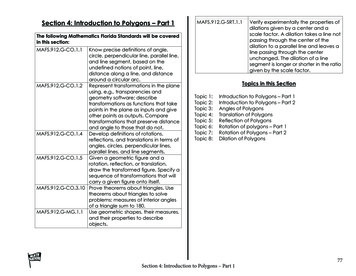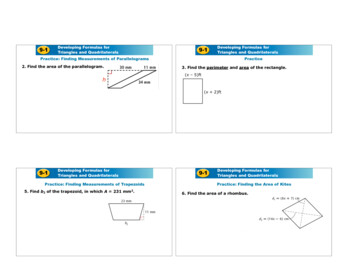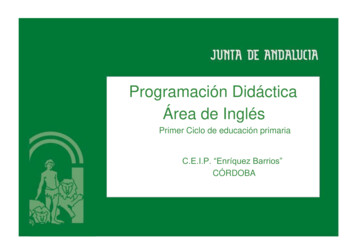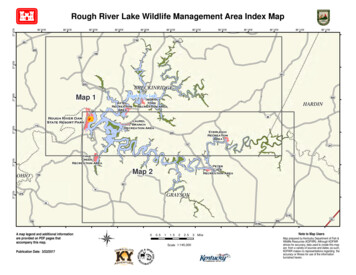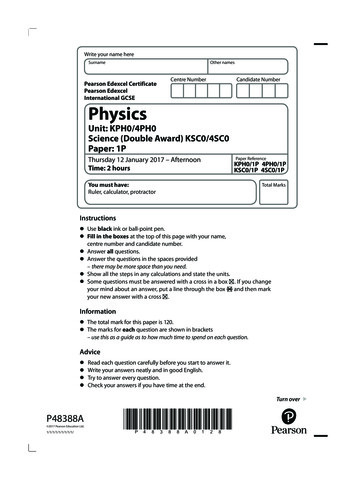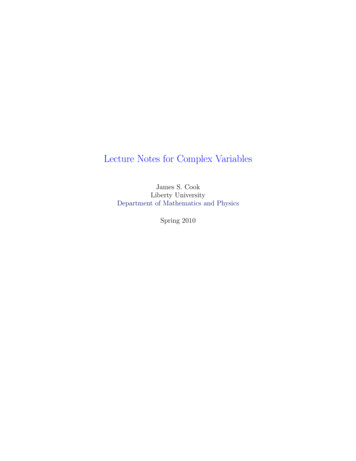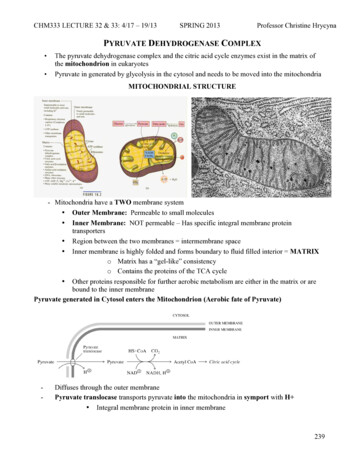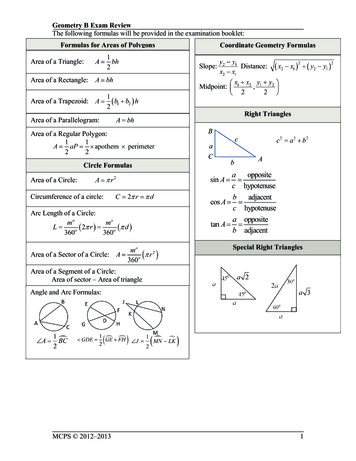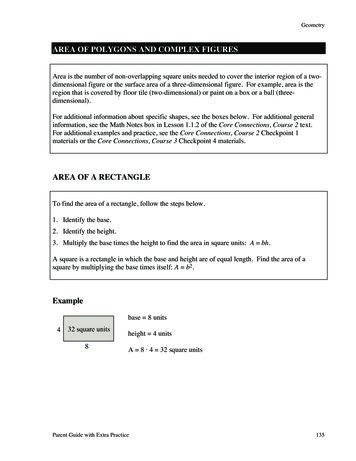
Transcription
GeometryAREA OF POLYGONS AND COMPLEX FIGURESArea is the number of non-overlapping square units needed to cover the interior region of a twodimensional figure or the surface area of a three-dimensional figure. For example, area is theregion that is covered by floor tile (two-dimensional) or paint on a box or a ball (threedimensional).For additional information about specific shapes, see the boxes below. For additional generalinformation, see the Math Notes box in Lesson 1.1.2 of the Core Connections, Course 2 text.For additional examples and practice, see the Core Connections, Course 2 Checkpoint 1materials or the Core Connections, Course 3 Checkpoint 4 materials.AREA OF A RECTANGLETo find the area of a rectangle, follow the steps below.1. Identify the base.2. Identify the height.3. Multiply the base times the height to find the area in square units: A bh.A square is a rectangle in which the base and height are of equal length. Find the area of asquare by multiplying the base times itself: A b2.Examplebase 8 units432 square units8height 4 unitsA 8 · 4 32 square unitsParent Guide with Extra Practice135
ProblemsFind the areas of the rectangles (figures 1-8) and squares (figures 9-12) below.1.2.3.2 mi4.5 cm4 mi6 cm3 in.7.3 units6.5.5 miles5.2 miles8m7 in.2m8.6.8 cm7.25 miles8.7 units3.5 cm2.2 miles9.10.11.12.8.61 feet1.5 feet8 cm2.2 cmAnswers1.8 sq. miles2.30 sq. cm3.21 sq. in.4.16 sq. m5.11 sq. miles6.26.1 sq. feet7.23.8 sq. cm8.15.95 sq. miles9.64 sq. cm10.4.84 sq. cm11.2.25 sq. feet12.13673.96 sq. feetCore Connections, Courses 1–3
GeometryAREA OF A tA parallelogram is easily changed to a rectangle by separating a triangle from one end of theparallelogram and moving it to the other end as shown in the three figures below. For additionalinformation, see the Math Notes box in Lesson 5.3.3 of the Core Connections, Course 1 text.baseparallelogramStep 1move triangleStep 2rectangleStep 3To find the area of a parallelogram, multiply the base times the height as you did with therectangle: A bh.Examplebase 9 cm6 cm height 6 cm9 cm A 9 · 6 54 square cmProblemsFind the area of each parallelogram below.1.2.3.8 cm6 feet4m10 cm8 feet4.5.3 cm6.7.5 in.13 cm12 in.7.11 m11.2 ft15 ft8.9.8 cm11.3 cmParent Guide with Extra Practice8.4 cm15.7 cm137
Answers1.48 sq. feet2.80 sq. cm3.44 sq. m4.39 sq. cm5.90 sq. in.6.168 sq. ft7.110.74 sq. cm8.131.88 sq. cmAREA OF A TRIANGLEheightheightheightbaseheightThe area of a triangle is equal to one-half the area of a parallelogram. This fact can easily beshown by cutting a parallelogram in half along a diagonal (see below). For additionalinformation, see Math Notes box in Lesson 5.3.4 of the Core Connections, Course 1 text.baseparallelogrambasedraw a diagonalStep 1Step 2basematch triangles by cutting apartor by foldingStep 3As you match the triangles by either cutting the parallelogram apart or by folding along thediagonal, the result is two congruent (same size and shape) triangles. Thus, the area of a trianglehas half the area of the parallelogram that can be created from two copies of the triangle.To find the area of a triangle, follow the steps below.1.Identify the base.2.Identify the height.3.Multiply the base times the height.4.Divide the product of the base times the height by 2: A Example 1base 16 cmheight 8 cmA 16 8 128 64cm 222138bh2or12bh .Example 28 cm16 cmbase 7 cm4 cmheight 4 cmA 7 42 2827 cm 14cm 2Core Connections, Courses 1–3
GeometryProblems1.2.3.6 cm12 ft8 cm13 cm14 ft4.5.6 cm6.1.5 m8 in.5 ft17 in.7.5m7 ft8.2.5 ft9 cm21 cm7 ftAnswers1.24 sq. cm2.84 sq. ft3.39 sq. cm4.68 sq. in.5.17.5 sq. ft6.3.75 sq. m7.94.5 sq. cm8.8.75 sq. ftAREA OF A TRAPEZOIDA trapezoid is another shape that can be transformed into a parallelogram. Change a trapezoidinto a parallelogram by following the three steps below.base (b)top (t)base (b)base (b)top (t)heightheightheightbase (b)top (t)heightbase (b)top (t)heighttop (t)Trapezoidduplicate the trapezoid and rotateput the two trapezoids together toform a parallelogramStep 1Step 2Step 3To find the area of a trapezoid, multiply the base of the large parallelogram in Step 3 (base andtop) times the height and then take half of the total area. Remember to add the lengths of thebase and the top of the trapezoid before multiplying by the height. Note that some texts call thetop length the upper base and the base the lower base.b tA 12 (b t)h or A h2For additional information, see the Math Notes box in Lesson 6.1.1 of the Core Connections,Course 1 text.Parent Guide with Extra Practice139
Example8 in.top 8 in.4 in.base 12 in.height 4 in.12 in.A 8 122 4 20 4 10 4 40 in.22ProblemsFind the areas of the trapezoids below.1.2.3.10 in.cm33 cm2 feetcm11cm4 feet8 in.cm55 cm5 feet15 in.4.5.6.7 in.11 cm8 cm5 in.15 cm11 m8m10 in.8m7.8.7 cm4 cm8.4 cm33cmcm10.5 cm6.56.5 cmcmAnswers1.4 sq. cm2.100 sq. in.3.14 sq. feet4.104 sq. cm5.42.5 sq. in.6.76 sq. m7.35 sq. cm8.22.35 sq. cm.140Core Connections, Courses 1–3
GeometryCALCULATING COMPLEX AREAS USING SUBPROBLEMSStudents can use their knowledge of areas of polygons to find the areas of more complicatedfigures. The use of subproblems (that is, solving smaller problems in order to solve a largerproblem) is one way to find the areas of complicated figures.Example 19"Find the area of the figure at right.8"4"11 "Method #1Method #29"8"AMethod #39"9"B 4"8"AB11"11 "Subproblems:Subproblems:8"4"4"11 "Subproblems:1. Find the area of rectangle A: 1. Find the area of rectangle A: 1. Make a large rectangle byenclosing the upper right8 · 9 72 square inches9 · (8 – 4) 9 · 4 36corner.square inches2. Find the area of rectangle B:2. Find the area of the new,2. Find the area of rectangle B:larger rectangle:4 · (11 – 9) 4 · 2 8square inches11 · 4 44 square inches8 · 11 88 square inches3. Add the area of rectangle Ato the area of rectangle B:72 8 80 square inches3. Add the area of rectangle A 3. Find the area of the shadedto the area of rectangle B:rectangle:36 44 80 square inches(8 – 4) · (11 – 9) 4 · 2 8 square inches4. Subtract the shadedrectangle from the largerrectangle:88 – 8 80 square inchesParent Guide with Extra Practice141
Example 210 cmFind the area of the figure at right.6 cm10 cm8 cmSubproblems:1. Make a rectangle out of the figure by enclosing the top.2. Find the area of the entire rectangle: 8 · 10 80 square cm6 cm10 cm3. Find the area of the shaded triangle. Use the formula A 12 bh . 16 square cm.b 8 and h 10 – 6 4, so A 12 (8 4) 3224. Subtract the area of the triangle from the area of the rectangle:80 – 16 64 square cm.8 cmProblemsFind the areas of the figures below.1.2.7'10 '6'3.7m15"19"18 m11 m9"20 '4.16 m5.6 yds2 yds17"6.8m5m10 m15 m8m3 yds10 yds15 m14 m7.8.7 cm3 cm9.7'5 cm2'10 cm12 cm20 '10 '8'24 cm7 cm6 cm2 cm4 cm22 '142Core Connections, Courses 1–3
Geometry10.11. Find the area of theshaded region.12 m12. Find the area of theshaded region.–14 '16 m8m18 m12 "9"–12 '8'7'7"15 "Answers1.158 sq. ft.2.225 sq. m.3.303 sq. in.4.42 sq. yd.5.95 sq. m.6.172.5 sq. m.7.252 sq. cm.8.310 sq. ft.9.23 sq. cm.10.11.148.5 sq. in.12.112 sq. ft.264 sq. m.PRISMS – VOLUME AND SURFACE AREASURFACE AREA OF A PRISMThe surface area of a prism is the sum of the areas of all of the faces, including the bases.Surface area is expressed in square units.For additional information, see the Math Notes boxes in Lessons 9.2.1 and 9.2.2 of the CoreConnections, Course 1 text and Lesson 9.2.4 of the Core Connections, Course 2 text.ExampleFind the surface area of the triangular prism at right.10 cmStep 1: Area of the 2 bases: 2 12 (6 cm)(8 cm) 48 cm27 cmStep 2: Area of the 3 lateral facesArea of face 1: (6 cm)(7 cm) 42 cm2Area of face 2: (8 cm)(7 cm) 56 cm2Area of face 3: (10 cm)(7 cm) 70 cm26 cm8 cmStep 3: Surface Area of Prism sum of bases and lateral faces:SA 48 cm2 42 cm2 56 cm2 70 cm2 216 cm2Parent Guide with Extra Practice143
ProblemsFind the surface area of each prism.1.2.3.5'12'5mm13'10 cm9mm5'8mm4 cm4.5. The pentagon isequilateral.10 cm6 cm6 cm4 cm6.2 cm10 cm52 ft 28 cm6 cm6 cm10 cm6 ft8 ftAnswers1.314 mm22.192 cm23.210 ft24.192 cm25.344 ft26.408 cm2144Core Connections, Courses 1–3
GeometryVOLUME OF A PRISMVolume is a three–dimensional concept. It measures the amount of interior space of a threedimensional figure based on a cubic unit, that is, the number of 1 by 1 by 1 cubes that will fitinside a figure.The volume of a prism is the area of either base (B) multiplied by the height (h) of the prism.V (Area of base) · (height) or V BhFor additional information, see the Math Notes boxes in Lesson 9.2.1 of the Core Connections,Course 1 text and Lesson 9.2.4 of the Core Connections, Course 2 text.Example 1Example 2Find the volume of the square prism below.Find the volume of the triangular prismbelow.579885The base is a square with area (B)8 · 8 64 units2.The base is a right triangle with area12(5)(7)Volume B(h) 64(5) 320 units3 17.5 units2.Volume B(h) 17.5(9) 157.5 units3Example 3Example 4Find the volume of the trapezoidal prismbelow.78Find the height of the prism with a volumeof 132.5 cm3 and base area of 25 cm2.132.515h 25h 5.3 cm10The base is a trapezoid witharea 12 (7 15) 8 88 units2.Parent Guide with Extra PracticeVolume B(h)132.5 25(h)Volume B(h) 88(10) 880 units3145
ProblemsCalculate the volume of each prism. The base of each figure is shaded.1.Rectangular Prism2.4 ftRight Triangular Prism3.Rectangular Prism5 in.6 cm6 in.8 cm3 ft4.Right Triangular Prism8.5 in.7 cm1 ft5.Trapezoidal Prism6.7.2 cmTriangular Prism withB 15 12 cm26'10'4.5 cm15 1 cm26'8 14 cm8'4 cm7.Find the volume of a prism with base area 32 cm2 and height 1.5 cm.8.Find the height of a prism with base area 32 cm2 and volume 176 cm3.9.Find the base area of a prism with volume 47.01 cm3 and height 3.2 cm.Answers1.12 ft36.127 8 cm314672.168 cm33.240 in.34.64.8 cm37.48 cm38.5.5 cm9.14.7 cm25.324 ft3Core Connections, Courses 1–3
GeometryNAMING QUADRILATERALS AND ANGLESA quadrilateral is any four-sided polygon. There are six special cases of quadrilaterals withwhich students should be familiar. Trapezoid – A quadrilateral with at least one pair of parallel sides. Parallelogram – A quadrilateral with both pairs of opposite sides parallel. Rectangle – A quadrilateral with four right angles. Rhombus – A quadrilateral with four sides of equal length. Square – A quadrilateral with four right angles and four sides of equal length. Kite – A quadrilateral with two distinct pairs of consecutive sides of equal length.Names of Basic AnglesAcute angles are angles with measures between (but not including) 0º and 90º, right anglesmeasure 90º, and obtuse angles measure between (but not including) 90ºand 180º. A straightangle measures 180º.37 acute90 right180 obtusestraightStudents use protractors to measure the size of angles.For more information see the Math Notes box in Lesson 8.3.1 of the Core Connections, Course 2text.Parent Guide with Extra Practice147
Example 1For the figure at right, describe the quadrilateral using all termsthat are appropriate.It is a rectangle since it has four right angles.It is a parallelogram since it has two pairs of parallel sides.It is also a trapezoid since it has at least one pair of parallel sides.Example 2Describe the angle at right as right, obtuse or acute. Estimate thesize of the angle and then use a protractor to measure the angle. Itmay be necessary to trace the angle and extend the sides.This angle opens narrower than a right angle so it is acute. Using aprotractor shows that the angle measures 60º.ProblemsFor each figure, describe the quadrilateral using all terms that are appropriate. Assume that sidesthat look parallel are parallel.1.2.3.4.5.6.148Core Connections, Courses 1–3
GeometryDescribe the angles below as right, obtuse or acute. Estimate the size of the angle and then use aprotractor to measure the ectangle,parallelogram,trapezoid5.square, rhombus,rectangle,parallelogram,trapezoid6.not a quadrilateral7.acute, 25 8.obtuse, 110 9.obtuse, 153 10.right, 90 11.Parent Guide with Extra Practiceacute, 80 12.acute, 82 149
ANGLE PAIR RELATIONSHIPSProperties of Angle PairsIntersecting lines form four angles. The pairs of angles across from each other are calledvertical angles. The measures of vertical angles are equal.xwz x and y are vertical angles w and z are vertical anglesyIf the sum of the measures of two angles is exactly 180º, then the angles are calledsupplementary angles. c and d aresupplementarycdc 110 d 70 If the sum of the measures of two angles is exactly 90º, then the angles are calledcomplementary angles. a and b arecomplementaryaa 30 bb 60 Angles that share a vertex and one side but have no common interior points (that is, do notoverlap each other) are called adjacent angles. m and n areadjacent anglesmnFor additional information, see the Math Notes boxes in Lesson 8.3.2 of the Core Connections,Course 2 text and Lesson 9.1.1 of the Core Connections, Course 3 text.150Core Connections, Courses 1–3
GeometryExample 1Example 2Find the measure of the missing angles ifm 3 50º.Classify each pair of angles below as vertical,supplementary, complementary, or adjacent.213441 23 5 m 1 m 3 (vertical angles) m 1 50ºa. 1 and 2 are adjacent andsupplementary 2 and 3 (supplementary angles) m 2 180º – 50º 130ºb. 2 and 3 are complementaryc. 3 and 5 are adjacent m 2 m 4 (vertical angles) m 4 130ºd. 1 and 4 are adjacent andsupplementarye. 2 and 4 are verticalProblemsFind the measure of each angle labeled with a variable.1.2.a3.80ºb4.35º5.6.75ºhfc75ºed120º gni 110º40ºm ljpk115ºAnswers1.m a 100º2.m b 55º3.m c 105ºm d 75ºm e 105º4.m f 50º5.m g 60ºm h 50ºm i 70º6.m j 75º m k 65ºm l 40º m m 140ºm n 105º m p 105ºParent Guide with Extra Practice151
PROPERTIES OF ANGLES, LINES, AND TRIANGLESStudents learn the relationships created when two parallel lines are intersected by a transversal.They also study angle relationships in triangles.Parallel linesTriangles91283 47 6 corresponding angles areequal: (exterior angle sum remote interior angles) alternate interior angles areequal: Also shown in the above figures: vertical angles are equal: m 1 m 2linear pairs are supplementary: m 3 m 4 180 and m 6 m 7 180 FIn addition, an isosceles triangle, ΔABC, has BA BCand m A m C . An equilateral triangle, ΔGFH, hasGF FH HG and m G m F m H 60 .BACHGFor more information, see the Math Notes boxes in Lessons 9.1.2, 9.1.3, and 9.1.4 of the CoreConnections, Course 3 text.Example 16x 8 49 Solve for x.Use the Exterior Angle Theorem: 6x 8 49 67 6x 108 x 108 x6 18 67 Example 2Solve for x.There are a number of relationships in this diagram. First, 1and the 127 angle are supplementary, so we know thatm 1 127 180 so m 1 53 . Using the same idea,m 2 47 . Next, m 3 53 47 180 , so m 3 80 .Because angle 3 forms a vertical pair with the angle marked7x 3 , 80 7x 3 , so x 11 .1527x 3 31127 2133 Core Connections, Courses 1–3
GeometryExample 35x 28 2x 46 Find the measure of the acute alternate interior angles.Parallel lines mean that alternate interior angles are equal, so5x 28 2x 46 3x 18 x 6 . Use either algebraic anglemeasure: 2(6 ) 46 58 for the measure of the acute angle.ProblemsUse the geometric properties you have learned to solve for x in each diagram and write theproperty you use in each case.1.2.3.60 100 80 x75 x65 4.x5.6.60 112 xx60 7.60 60 4x 10 8.45 x8x – 60 9.125 3x68 5x10.11.5x 12 12.128 58 10x 2 30 3x19x 3 13.14.142 38 15.142 20x 2 20x – 2 Parent Guide with Extra Practice38 128 52 7x 3 153
16.17.18.x52 5x 3 8x58 23 128 57 117 19.20.21.8x – 18 cm18 5x 36 8x – 12 in.12x – 18 in.9x5x 3 cm22.23.24.70 13x 2 5x – 18 25.15x – 2 5x – 10 50 26.27.45 40 7x – 4 3x 20 2x 5 5x 8 28.7x – 4 6x – 4 5x 8 Answers1.45 2.35 3.40 4.34 5.12.5 6.15 7.15 8.25 9.20 10.5 11.3 12.10 23 13.7 14.2 15.7 16.25 17.81 18.7.5 19.9 20.7.5 21.7 22.15.6 23.26 24.2 25.40 26.65 27.7 16 28.10 154Core Connections, Courses 1–3
GeometryCIRCLES – CIRCUMFERENCE AND AREACIRCUMFERENCEradiusThe radius of a circle is a line segment from its center to any point onthe circle. The term is also used for the length of these segments. Morethan one radius are called radii. A chord of a circle is a line segmentjoining any two points on a circle. A diameter of a circle is a chord thatgoes through its center. The term is also used for the length of thesechords. The length of a diameter is twice the length of a radius.The circumference of a circle is similar to the perimeter of a polygon.The circumference is the length of a circle. The circumference wouldtell you how much string it would take to go around a circle once.diameterchordCircumference is explored by investigating the ratio of the circumference to the diameter of acircle. This ratio is a constant number, pi (π). Circumference is then found by multiplying π by, 3.14, or the π button on their calculator, depending on thethe diameter. Students may use 227teacher’s or the book’s directions.C 2π r or C πdFor additional information, see the Math Notes boxes in Lessons 8.3.3 and 9.1.2 of the CoreConnections, Course 2 text or Lesson 3.2.2 of the Core Connections, Course 3 text. Foradditional examples and practice, see the Core Connections, Course 3 Checkpoint 4 materials.Example 1Example 2Example 3Find the circumferenceof a circle with adiameter of 5 inches.Find the circumference of acircle with a radius of 10 units.Find the diameter of a circlewith a circumference of163.28 inches.d 5 inchesr 10, so d 2(10) 20C πd π(5) or 3.14(5) 15.7 inchesC 3.14(20) 62.8 unitsC πd163.28 π d163.28 3.14d163.28d 3.14 52 inchesParent Guide with Extra Practice155
ProblemsFind the circumference of each circle given the following radius or diameter lengths. Roundyour answer to the nearest hundredth.1.d 12 in.2.d 3.4 cm3.r 2.1 ft4.d 25 m5.r 1.54 miFind the circumference of each circle shown below. Round your answer to the nearesthundredth.6.7. 4'10 cmFind the diameter of each circle given the circumference. Round your answer to the nearest tenth.8.C 48.36 yds9.C 35.6 ft10. C 194.68 mmAnswers1.37.68 in.2.10.68 cm.3.13.19 ft4.78.5 m5.9.67 mi6.25.12 ft7.31.40 cm8.15.4 yds9.11.3 ft10.62 mm156Core Connections, Courses 1–3
GeometryAREA OF A CIRCLEIn class, students have done explorations with circles and circular objects to discover therelationship between circumference, diameter, and pi (π). To read more about the in-classexploration of area, see problems 9-22 through 9-26 (especially 9-26) in the Core Connections,Course 2 text.In order to find the area of a circle, students need to identify the radius of the circle. The radiusis half the diameter. Next they will square the radius and multiply the result by π. Depending onthe teacher’s or book’s preference, students may use 22for π when the radius or diameter is a7fraction, 3.14 for π as an approximation, or the π button on a calculator. When using the πbutton, most teachers will want students to round to the nearest tenth or hundredth.The formula for the area of a circle is: A r2π.Example 1Example 2Find the area of a circle with r 17 feet.Find the area of a circle with d 84 cm.A (17 ) π (17 · 17) (3.14) 907.46 square feetr 42 cm2A ( 42 ) π (42 · 42) (3.14) 5538.96 square cm2ProblemsFind the area of the circles with the following radius or diameter lengths. Use 3.14 for the valueof π. Round to the nearest hundredth.1.r 6 cm5.d 9.d 14.5 ft45cm122. r 3.2 in.3.d 16 ft4.r m6. r 5 in.7.r 3.6 cm8.r 2 4 in.110. r 12.02 mAnswers1.113.04 cm22.32.15 in.23.200.96 ft24.1114m25.881756.78.5 in.27.40.69 cm28.5115 56or 15.90 in29.165.05 ft210.453.67 m2Parent Guide with Extra Practicecm2157
RIGID TRANSFORMATIONSStudying transformations of geometric shapes builds a foundation for a key idea ingeometry: congruence. In this introduction to transformations, the students explore threerigid motions: translations, reflections, and rotations. A translation slides a figurehorizontally, vertically or both. A reflection flips a figure across a fixed line (for example,the x-axis). A rotation turns an object about a point (for example, (0, 0) ). This explorationis done with simple tools that can be found at home (tracing paper) as well as with computersoftware. Students change the position and/or orientation of a shape by applying one ormore of these motions to the original figure to create its image in a new position withoutchanging its size or shape. Transformations also lead directly to studying symmetry inshapes. These ideas will help with describing and classifying geometric shapes later in thecourse.For additional information, see the Math Notes box in Lesson 6.1.3 of the CoreConnections, Course 3 text.Example 1Decide which transformation was used on each pair of shapes below. Some may be acombination of transformations.a.b.c.d.e.f.158Core Connections, Courses 1–3
GeometryIdentifying a single transformation is usually easy for students. In part (a), the parallelogram isreflected (flipped) across an invisible vertical line. (Imagine a mirror running vertically betweenthe two figures. One figure would be the reflection of the other.) Reflecting a shape oncechanges its orientation, that is, how its parts “sit” on the flat surface. For example, in part (a), thetwo sides of the figure at left slant upwards to the right, whereas in its reflection at right, theyslant upwards to the left. Likewise, the angles in the figure at left “switch positions” in the figureat right.In part (b), the shape is translated (or slid) to the right and down. The orientation is the same.Part (c) shows a combination of transformations. First the triangle is reflected (flipped) across aninvisible horizontal line. Then it is translated (slid) to the right. The pentagon in part (d) hasbeen rotated (turned) clockwise to create the second figure. Imagine tracing the first figure ontracing paper, then holding the tracing paper with a pin at one point below the first pentagon,then turning the paper to the right (that is, clockwise) 90 . The second pentagon would be theresult. Some students might see this as a reflection across a diagonal line. The pentagon itselfcould be, but with the added dot, the entire shape cannot be a reflection. If it had been reflected,the dot would have to be on the corner below the one shown in the rotated figure. The trianglesin part (e) are rotations of each other (90 clockwise again). Part (f) shows another combination.The triangle is rotated (the horizontal side becomes vertical) but also reflected since the longestside of the triangle points in the opposite direction from the first figure.Example 2yTranslate (slide) ΔABC right six units and up three units. Give thecoordinates of the new triangle.The original vertices are A(–5, –2), B(–3, 1), and C(0, –5). The newvertices are A' (1, 1), B ' (3, 4), and C ' (6, –2). Notice that the change toeach original point (x, y) can be represented by ( x 6, y 3 ).B'BA'xC'ACExample 3Reflect (flip) ΔABC with coordinates A(5, 2), B(2, 4), and C(4, 6) acrossthe y-axis to get ΔA' B'C ' . The key is that the reflection is the samedistance from the y-axis as the original figure. The new points areA ' (–5, 2), B ' (–2, 4), and C ' (–4, 6). Notice that in reflecting across they-axis, the change to each original point (x, y) can be represented by(–x, y).C'yB'CBA'AP xQIf you reflect ΔABC across the x-axis to get ΔPQR , then the new pointsare P(5, –2), Q(2, –4), and R(4, –6). In this case, reflecting across thex-axis, the change to each original point (x, y) can be represented by (x, –y).Parent Guide with Extra PracticeR159
Example 4yB'CRotate (turn) ΔABC with coordinates A(2, 0), B(6, 0), and C(3, 4) 90 C'A'counterclockwise about the origin (0, 0) to get ΔA' B'C ' with coordinates B''A '(0, 2), B ' (0, 6), and C ' (–4, 3). Notice that for this 90 ABxA''counterclockwise rotation about the origin, the change to each originalC''point (x, y) can be represented by (–y, x).Rotating another 90 (180 from the starting location) yields ΔA"B"C "with coordinates A"(–2, 0), B"(–6, 0), and C"(–3, –4).For this 180 counterclockwise rotation about the origin, the change to each original point (x, y)can be represented by (–x, –y). Similarly a 270 counterclockwise or 90 clockwise rotation aboutthe origin takes each original point (x, y) to the point (y, –x).ProblemsFor each pair of triangles, describe the transformation that moves triangle A to the location oftriangle B.1.2.AABB3.4.ABBAFor the following problems, refer to the figures below:Figure AFigure ByyBCAxAFigure CyCBABxxC160Core Connections, Courses 1–3
GeometryState the new coordinates after each transformation.5.Slide figure A left 2 units and down 3 units.6.Slide figure B right 3 units and down 5 units.7.Slide figure C left 1 unit and up 2 units.8.Flip figure A across the x-axis.9.Flip figure B across the x-axis.10.Flip figure C across the x-axis.11.Flip figure A across the y-axis.12.Flip figure B across the y-axis.13.Flip figure C across the y-axis.14.Rotate figure A 90 counterclockwise about the origin.15.Rotate figure B 90 counterclockwise about the origin.16.Rotate figure C 90 counterclockwise about the origin.17.Rotate figure A 180 counterclockwise about the origin.18.Rotate figure C 180 counterclockwise about the origin.19.Rotate figure B 270 counterclockwise about the origin.20.Rotate figure C 90 clockwise about the origin.Answers (1 – 4 may vary; 5–20 given in the order A ' , B ' , C ' )1.translation2.rotation and translation3.reflection4.rotation and translation5.(–1, –3) (1, 2) (3, –1)6.(–2, –3) (2, –3) (3, 0)7.(–5, 4) (3, 4) (–3, –1)8.(1, 0) (3, – 4) (5, –2)9.(–5, –2) (–1, –2) (0, –5)10.(– 4, –2) (4, –2) (–2, 3)11.(–1, 0) (–3, 4) (–5, 2)12.(5, 2) (1, 2) (0, 5)13.(4, 2) (– 4, 2) (2, –3)14.(0, 1) (– 4, 3) (–2, 5)15.(–2, –5) (–5, 0) (–2, –1)16.(–2, –4) (–2, 4) (3, –2)17.(–1, 0) (–3, – 4) (–5, –2)18.(4, –2) (– 4, –2) (2, 3)19.(2, 5) (2, 1) (5, 0)20.(2, 4) (2, – 4) (–3, 2)Parent Guide with Extra Practice161
SIMILAR FIGURESTwo figures that have the same shape but not necessarily the same size are similar. In similarfigures the measures of the corresponding angles are equal and the ratios of the correspondingsides are proportional. This ratio is called the scale factor. For information about correspondingsides and angles of similar figures see Lesson 4.1.1 in the Core Connections, Course 2 text or theMath Notes box in Lesson 6.2.2 of the Core Connections, Course 3 text. For information aboutscale factor and similarity, see the Math Notes boxes in Lesson 4.1.2 of the Core Connections,Course 2 text or Lesson 6.2.6 of the Core Connections, Course 3 text.Example 1Determine if the figures are similar. If so, what is the scale factor?11 cm9 cm3913 3311 279 13 or 313 cm33 cmThe ratios of corresponding sidesare equal so the figures are similar.The scale factor that compares the smallfigure to the large one is 3 or 3 to 1. Thescale factor that compares the large figure tothe small figure is 13 or 1 to 3.27 cm39 cmExample 2Determine if the figures are similar. If so, state the scale factor.8 ft9 ft6 ft12 ft6 ft4 ft64 12 96 and all equal886 4332.so the shapes are not similar.6 ft8 ft162Core Connections, Courses 1–3
GeometryExample 3Determine the scale factor for the pair of similar figures. Use the scale factor to find the sidelength labeled with a variable.8 cmscale factor x5 cmoriginal 53 new3 cmoriginal358 53 x ; x new245 4.8 cmProblemsDetermine if the figures are similar. If so, state the scale factor of the first to the second.1.2. Parallelograms612816520103. Kites42.5458103467.58Determine the scale factor for each pair of similar figures. Use the scale factor to find the sidelabeled with the variable.4.5.y526103x6.5y7.4615x8a685Parent Guide with Extra Practicetz4bc101215163
Answers1.similar; 22.; x 7.54.526.4; x37.52 2035.3; y2245 1.6253 8 133.not similar 9 6 23 , y 163 5 13 , t 8, z ; a 16 3.2, b 585similar; 4.8, c 6PYTHAGOREAN THEOREMA right triangle is a triangle in which the two shorter sides forma right angle. The shorter sides are called legs. Opposite theright angle is the third and longest side called the hypotenuse.legThe Pythagorean Theorem states that for any right triangle, thesum of the squares of the lengths of the legs is equal to thesquare of the length of the hypotenuse.legleg 1(leg 1)2 (leg 2)2 (hypotenuse)2hypotenusehypotenuseleg 2For additional information, see Math Notes box in Lesson 9.2.3 of the Core Connections,Course 3 text.Example 1Use the Pythagorean Theorem to find x.a.x5x121085 2 12 2 x 2x 2 8 2 10 225 144 x 2x 2 64 100169 x 213 x164b.x 2 36x 6Core Connections, Courses 1–3
GeometryExample 2Not all problems will have exact answers. Use square root notation and your calculator.42 m216 m2m2mm410 102 100 84 84 9.17Example 3A guy wire is needed to support a tower. The wire is attached to the ground five meters from thebase of the tower. How long is the wire if the tower is 10 meters tall?First draw a diagram to model the problem, then write an equation using the PythagoreanTheorem and solve it.x2x2x2xx10 102 52 100 25 125 125 11.18 cm5ProblemsWrite an equation and solve it to find the length of the unknown side. Round answers to thenearest hundredth.1.2.3.1229a5218xx84.5.y56.610Parent Guide with Extra Practice10cb2
information, see the Math Notes box in Lesson 1.1.2 of the Core Connections, Course 2 text. For additional examples and practice, see the Core Connections, Course 2 Checkpoint 1 materials or the Core Connections, Course 3 Checkpoint 4 materials. AREA OF A RECTANGLE To find the area of a rectangle, follow the steps below. 1. Identify the base. 2.

